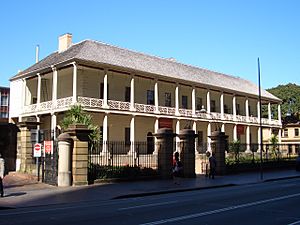Museums of History NSW facts for kids

Museums of History NSW logo
|
|
 The Mint – Headquarters of MHNSW |
|
| Agency overview | |
|---|---|
| Formed | 2022 |
| Preceding |
|
| Jurisdiction | New South Wales |
| Headquarters | The Mint, 10 Macquarie Street, Sydney, Australia |
| Employees | 354 (2024) |
| Annual budget | A$73.6 million |
| Minister responsible |
|
| Agency executives |
|
| Parent department | Department of Enterprise, Investment and Trade |
| Parent agency | Create NSW |
| Child agencies |
|
| Key documents |
|
Museums of History NSW is a special group that looks after important historic places, collections, and old records in New South Wales, Australia. It's like a guardian for the state's history! In 2023, two big groups joined together to create Museums of History NSW. These were the State Archives and Records Authority and Sydney Living Museums. Sydney Living Museums used to be called the Historic Houses Trust of New South Wales. This new organization now takes care of many amazing places. These include old houses, beautiful gardens, parks, and city areas.
Contents
History of Museums of History NSW
Museums of History NSW was formed in 2023. It brought together two important organizations. One was the State Archives and Records Authority. The other was Sydney Living Museums.
The Historic Houses Trust
The Historic Houses Trust started in 1980. Its first job was to manage Elizabeth Bay House and Vaucluse House. Over time, the Trust grew. It began to look after 12 different houses, gardens, and museums. The Trust also cares for over 48,000 special items. These items are spread across all its sites.
Becoming Sydney Living Museums
In 2013, the Historic Houses Trust changed its name. It became Sydney Living Museums. This new name helped to show its many different properties. It also highlighted its important role for people today and in the future.
Joining Forces: MHNSW
In 2023, Sydney Living Museums merged with the State Archives and Records Authority. This merger created the new organization we know today. It is called Museums of History NSW. This means even more history is now looked after by one group.
Historic Sites and Museums
Museums of History NSW manages many interesting properties. These places help us learn about the past. They include old homes, barracks, and special museums.
| Property | Image | Acquired/ assumed management |
Date opened | Status |
|---|---|---|---|---|
| Elizabeth Bay House, Onslow Avenue, Elizabeth Bay |  |
1980 | 1980 | Museum |
| Elizabeth Farm, Alice Street, Rose Hill |  |
1984 | 1984 | Museum |
| Hyde Park Barracks, Macquarie Street, Sydney |  |
1990 | 1991 | Museum |
| Justice & Police Museum, Circular Quay, Sydney |  |
1990 | 1991 | Museum |
| Meroogal, Cnr West & Worrigee Streets, Nowra | 1985 | 1988 | Museum | |
| Museum of Sydney, Corner Philip & Bridge Streets, Sydney |  |
1990 | 1995 | Museum |
| Rouse Hill Estate, Rouse Hill |  |
1987 | 1999 | Museum |
| Rose Seidler House, Clissold Road, Wahroonga |  |
1988 | 1991 | Museum |
| Susannah Place, The Rocks, Sydney |  |
1990 | 1993 | Museum |
| The Mint, Macquarie Street, Sydney |  |
1998 | 1998 and 2004 | Offices and the Caroline Simpson Library |
| Vaucluse House, Wentworth Road, Vaucluse |  |
1980 | 1980 | Museum |
See also
- National Trust of Australia (New South Wales)

